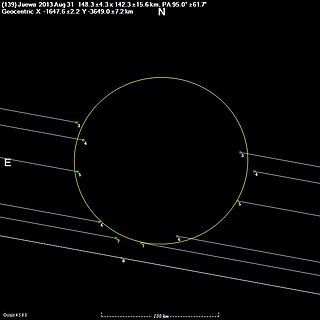
139 Juewa is a very large and dark main belt asteroid. It is probably composed of primitive carbonaceous material. It was the first asteroid discovered from China.

Terpsichore is a large and very dark main-belt asteroid. It has most probably a very primitive carbonaceous composition. It was found by the prolific comet discoverer Ernst Tempel on September 30, 1864. It is named after Terpsichore, the Muse of dance in Greek mythology.
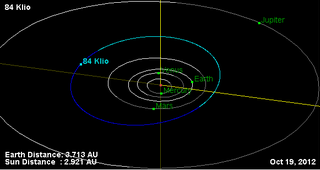
Klio is a fairly large and very dark main-belt asteroid. It was discovered by R. Luther on August 25, 1865, and named after Clio, the Muse of history in Greek mythology. The name Clio had previously been suggested by the discoverer of 12 Victoria, and that is the name B. A. Gould, editor of the prestigious Astronomical Journal, adopted for that asteroid, because of the controversy over the name Victoria. An occultation by Klio over a dim star was observed on April 2, 1997.

Klotho is a fairly large main-belt asteroid. While it is an M-type, its radar albedo is too low to allow a nickel-iron composition. Klotho is similar to 21 Lutetia and 22 Kalliope in that all three are M-types of unknown composition. Klotho was found by Ernst Tempel on February 17, 1868. It was his fifth and final asteroid discovery. It is named after Klotho or Clotho, one of the three Moirai, or Fates, in Greek mythology.
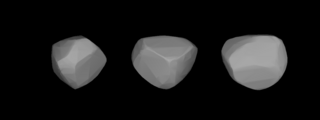
Ianthe is a large main-belt asteroid, named for three figures in Greek mythology. It is very dark and is composed of carbonates. It was one of the numerous discoveries by C. H. F. Peters, who found it on April 18, 1868, from Clinton, New York.

Ate is a main-belt asteroid discovered by the German-American astronomer C. H. F. Peters on August 14, 1870, and named after Ate, the goddess of mischief and destruction in Greek mythology. In the Tholen classification system, it is categorized as a carbonaceous C-type asteroid, while the Bus asteroid taxonomy system lists it as an Ch asteroid.

Iphigenia is a fairly large and exceedingly dark main-belt asteroid. It is classified as a C-type asteroid, and therefore probably has a primitive carbonaceous composition. It was discovered by German-American astronomer C. H. F. Peters on September 19, 1870, and named after Iphigenia, a princess sacrificed by her father in Greek mythology. The orbital elements for 112 Iphigenia were published by German astronomer Friedrich Tietjen in 1871.
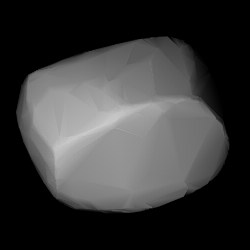
Lomia is a large main-belt asteroid that has a nearly circular orbit; the orbital eccentricity is 0.029. It was discovered by French astronomer Alphonse Borrelly on September 12, 1871, from the Marseilles Observatory. The preliminary orbital elements were published in the following year by German astronomer Friedrich Tietjen. The reason for the name is uncertain, but Lutz D. Schmadel believes it is most likely a misspelling of Lamia, the female demon of Greek mythology.
Velleda is a main-belt asteroid. It is probably a rather typical, albeit sizable, S-type asteroid. Named for Veleda, a priestess and prophet of the Germanic tribe of the Bructeri. It was discovered by Paul Henry on November 5, 1872, in Paris, France. It was his first credited discovery. He and his brother Prosper Henry discovered a total of 14 asteroids.
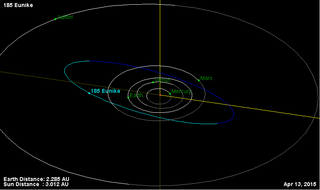
Eunike is a dark and very large main-belt asteroid, with an approximate diameter of 157 kilometres. It has a primitive carbonaceous composition.

Dynamene is a large dark main-belt asteroid that was discovered by German-American astronomer Christian Heinrich Friedrich Peters on July 27, 1879, in Clinton, New York. The name derives from Dynamene, one of the fifty Nereids in Greek mythology. Based upon its spectrum, 200 Dynamene is classified as a C-type asteroid, indicating that it probably has a primitive composition similar to the carbonaceous chondrite meteorites. The spectra of the asteroid displays evidence of aqueous alteration.
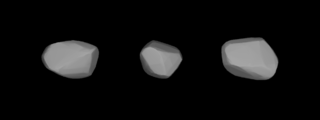
Amherstia was the 8th asteroid discovered by Raymond Smith Dugan, and was named after Amherst College, his alma mater. Amherstia is a large M-type main belt asteroid, with an estimated diameter of 73 km. It follows an eccentric orbit between Jupiter and Mars, with an orbital period of 4.39 years. The orbital plane is inclined at an angle of 13° to the ecliptic.
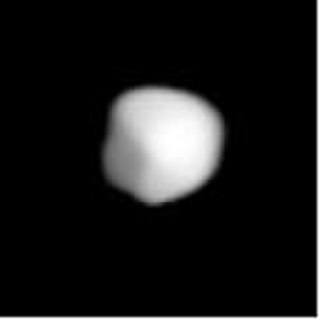
Athamantis is a fairly large main-belt asteroid that was discovered by the German-Austrian astronomer K. de Ball on September 3, 1882, in Bothkamp. It was his only asteroid discovery. The asteroid was named after Athamantis, daughter of Athamas the mythical Greek king of Orchomenus.
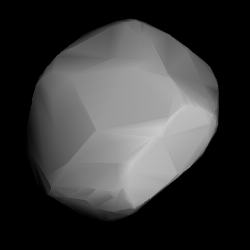
Hypatia is a very large main-belt asteroid that was discovered by Russian astronomer Viktor Knorre on July 1, 1884, in Berlin. It was the third of his four asteroid discoveries. The name was given in honour of philosopher Hypatia of Alexandria. Based upon the spectrum, it is classified as a C-type asteroid and is probably composed of primitive carbonaceous material. Like many asteroids of this type, its surface is very dark in colour.
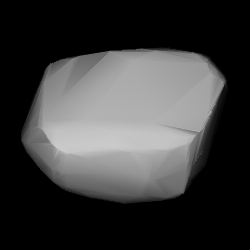
Chicago is a very large main-belt asteroid. It is classified as a C-type asteroid and is probably composed of carbonaceous material.
Liguria is a very large main-belt asteroid that was discovered by Auguste Charlois on January 21, 1893, in Nice. It is one of seven of Charlois's discoveries that was expressly named by the Astromomisches Rechen-Institut, and was named for the Italian region.

Myrrha is a main-belt asteroid that was discovered by the French astronomer Auguste Charlois on January 10, 1894, in Nice. It has been classified as a C-type asteroid and is most likely composed of carbonaceous material.

Siegena is a very large main-belt asteroid. It is classified as a C-type asteroid and is probably composed of primitive carbonaceous material.

690 Wratislavia is a minor planet orbiting the Sun. Wratislavia was discovered on October 16, 1909. IRAS data shows it is about 135 km in diameter.
790 Pretoria is a minor planet orbiting the Sun that was discovered by English astronomer Harry Edwin Wood on January 16, 1912. It is a member of the Cybele group located beyond the core of the main belt and named after Pretoria, the capital city of South Africa.

















